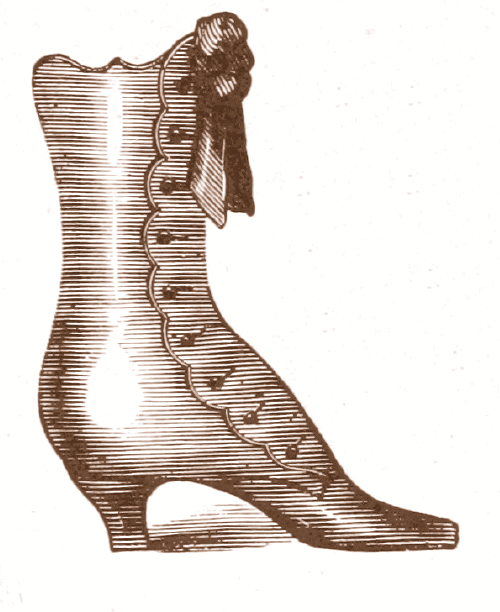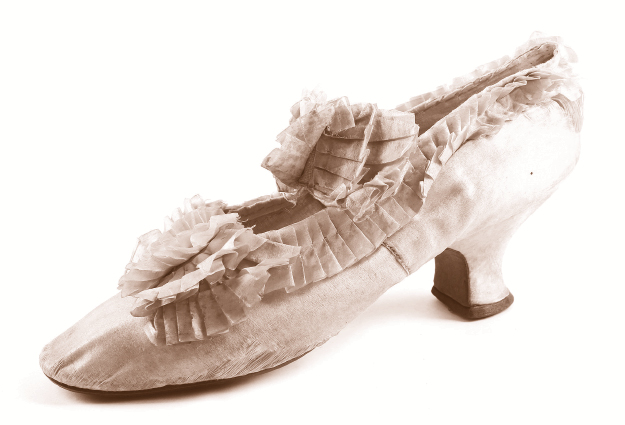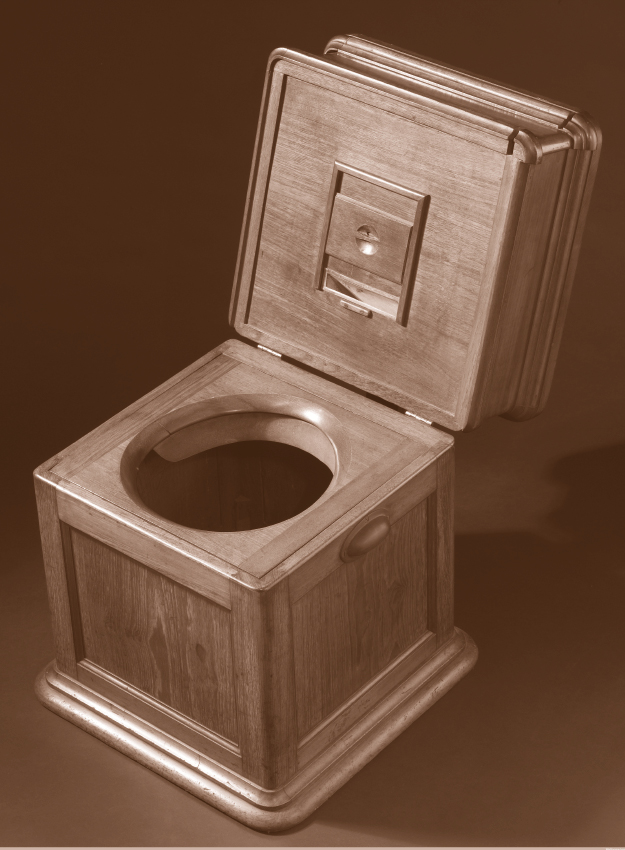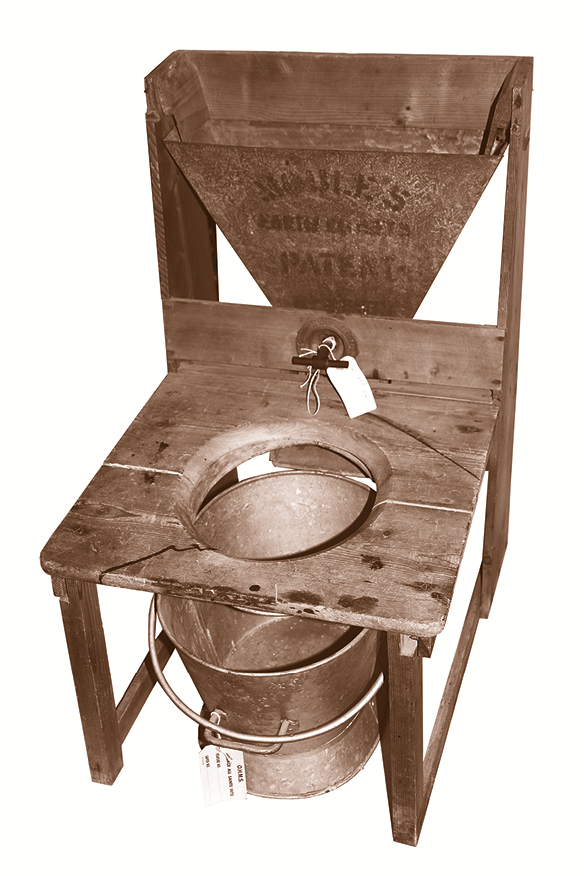I want you to look at your nineteenth-century shoes. We wouldn’t call them shoes today.
They’re boots, made of black leather and usually ascending halfway up the calf, fitting closely, with a hard wooden sole. Once you wedge your foot into them, they are fastened by means of tightly spaced buttons, which, if you are in the unfortunate position of ever having to dress yourself, are freakishly difficult to manipulate. So difficult that a special hook has been invented to make it possible. By modern standards these shoes should be placed next to the fuzzy handcuffs in the window of the kind of store that sells edible massage oil.

Fashionable, yet uncomfortable enough to keep your gal from wandering
So why don’t you see if you can find something a little less daunting to wear on your feet today? Oh, there’s a darling pair! Delicate color, small and sweet. Your maid insists they are merely “house slippers,” but they look like the closest thing to actual shoes available. What sort of slippers are made of kid leather and satin, anyway? They aren’t even fluffy.
Now, out you go on the town, in your prim but chic little slip-on shoes!
Hello! Back so soon?

Venetian silk slipper
Oh, heavens. You descended your front steps and landed directly in a pig wallow of “mud,” which you’re pretty sure is 90 percent horse excrement? Oh, poor child! Deep down you know that’s not just from horses. Come, now. Don’t delude yourself, darling, it just makes this journey harder.
The nineteenth century is so, so dirty. Whether you’re rich or poor, living on a farm or in the city, you are going to be ankle deep in filth wherever you go.
Filthiest. Century. Ever.
Some would argue that the nineteenth century was one of the filthiest times in all of Western history, particularly in any urban, developed area. Worse than when humans squatted in caves picking lice off each other. (By the way, you’ll probably still have to do this on occasion. It’s where the term “nit-picking” comes from. But, take heart, not in a cave, and to squat or not will be entirely at your discretion. So there’s that!)
Ankle deep in filth, I said, but forgive me, I was inaccurate. You will wish the filth terminated at your ankles. Foulness is everywhere. Grime and rot cling to the very air, the buildings, the people; even the soap is made out of lard and poison.
There is no such thing as “fresh air” in the larger cities, unless the winds are blowing it in from other locations, usually at such an icy speed that the fresh air poses a greater threat than the miasma it displaced. There is no electricity and little available in the line of “clean burning” fuels (whale oil burns exceptionally well, but since you still possess a twenty-first-century conscience, you are a heartless monster if you use it). Yet every home and business needs energy, so you must burn something, like wood or coal. Burn for heat, burn for light, and burn for steam power. The result is the soot and smoke of hundreds of thousands of fires saturating the sky.

Flea Crush. Way better than playing Candy Crush.
And these fires don’t produce a charming campfire smell. Though if they did, it wouldn’t matter because even that wouldn’t come close to masking the other smells. Remember your street, stretching before you, filled to the horizon with sewage, rotting offal, and other garbage? Life requires people to perform actions that create waste. And like the smoke that hangs above your city, the more solid pollution is there because it has nowhere else to go.
Regarding the fetid road sludge we’ll have to call mud: one of the reasons it is so bad is that most of those streets weren’t engineered; they simply appeared as they were needed. Many American streets started out as deer trails, and deer aren’t known for ecological foresight. Such streets lack all those little whispers of design and maintenance that would send runoff to gutters and ditches to be carried away. Instead the runoff forms pools and collects in holes of stagnated, polluted “water.”
In summertime the mud won’t be such a problem, unless it’s a wet summer, and then, well, malaria. (A French surgeon will be awarded the Nobel Prize for discovering the disease is caused by mosquitoes that congregate around stagnant water—but that won’t be until 1907, much too late for you. So really watch out for mosquitoes.) In summer you will have dust, endless choking dust, kicked up by every horse and carriage that passes. Bup bup bup! No. Don’t bother starting in about cobblestones. Yes, they exist, and they help somewhat with dust and sludge, but I am not setting you down in any of the places that have them because most places don’t and frankly you’ve already been cut enough breaks on this journey.

Particularly tidy Boston alley, 1890s
Now back to general filth in your new romantic life. Some things contribute more heavily to the problem. Take the issue of sewage treatment.
There is no sewage treatment.
There are sometimes conduits that sort of feel like sewers. Streets and a few municipal pipes dump all matter of soggy refuse into these tunnels, and the tunnels in turn carry the awfulness far, far away.
Well, not so far.
Actually, to the nearest large body of water. Which is usually located right in the center of town. Like the Thames, the Seine, or the Hudson. By 1860, the Thames, for instance, was visited by thousands of tons of fecal matter every day from all the pipes and runoffs that emptied into it. Imagine the smell on a hot day. Then get over it quickly because the smell is nothing.
The smell isn’t the problem. The problem is that these bodies of water and their thoroughly polluted water tables are also where urban residents get their drinking water. For much of the nineteenth century, doctors didn’t even know what germs were and certainly didn’t think deadly invisible animals could exist to a fatal capacity in water, like so many tiny rabid unicorns.
People died because of this. By the thousands they died, from cholera, dysentery, typhoid. Diseases that occur when your body desperately tries to flush unwelcome bacteria from its digestive tract, usually killing you by dehydration in the process. Especially when your loved ones try to soothe your thirst by giving you more poisoned water.

Death patrols the Thames, which is filled with refuse.
Dirty water didn’t even enter people’s minds as a source of illnesses. They believed that bad air caused disease, which at least was an improvement on the previous century’s obsession with removing “bad blood” from dying patients by the half-gallon. And some Victorian doctors still do that, so pick your physician wisely. Actually, don’t—don’t go to physicians.
You know better, dear. You know that it would be wise during your visit to stick to coffee and alcoholic beverages, because their methods of preparation kill bacteria. Now let me tell you why you know that.
There was a man, beautifully named given his influence on our world: Dr. John Snow. He treated cholera victims daily, breathed the same contaminated air, but never got sick. He was breathing their air, but he wasn’t drinking their water. He drew a map of all the cholera victims in a certain neighborhood of London and noticed that all the worst outbreaks were centered on one thing: a single well pump. A dirty one, contaminated by sewage. Even stranger, there was one place in that neighborhood that suffered no cholera at all. And that was the brewery, where employees were apparently allowed to imbibe their own stock as their main beverage of the day.

“The outhouse is there, the slop water is there… just to keep things sanitary we better dig the well between them.”
Dr. Snow retaught the world something it must once have known instinctually but had been forced to forget in order to survive overpopulation.
Do not poop next to where you drink.
And so midcentury, sanitation reform began in most major cities of the Western world. Better sewers, better garbage disposal. Cities began employing enormous task forces to keep their streets from being hell pits of disease and squalor. Which… ehh… helped?
But our twenty-first-century senses would still be assaulted. There were still limited disposal options for garbage, and endless smoke choking the air. Sanitation reform also couldn’t change the fact that most people still needed to use outhouses, pit toilets, and latrines for their daily evacuations. Something you are going to have to get used to also.
The Lady’s Toilette and Her Thunder Mug
I know you’ve come a long way, and no doubt one of your express intentions was to be in a place where people did not discuss their bodily functions in casual company. And now here you are again, listening to your (nineteenth-century version) mother complaining about how “her toilet” took an exceptionally long time today. You might as well have just stayed in the twenty-first century and endured the same discussions with her via cell phone.
But stout hearts, now. “Toilet” means something different here. We appropriated our word for the modern plumbing fixture from the French, who said it more like twa-lette. It came from a word similar to “toil,” that is, to do work, a job. A “duty,” or “doody,” one might say.
Ah, heavens. I’m sorry. Punning is the very lowest form of humor, and I do apologize.
Until well into the twentieth century “a lady’s toilet” was her beauty routine, the work she did to make herself presentable before facing the world. Then one day, that included pooping in an indoor flushable basin, but no lady wanted to say that, so it simply became part of her “toilet.” Then, the success of the appliance caused such a large, powerful movement that it just took over the word. (I’m sorry. I’m very cross at myself.)
All humans, always, have striven to remove their bodily waste far from the areas where they did the rest of their living (except when overcrowding—see above—made that impossible). This removal was mostly done by one form or another of burying. Technically that’s all an outhouse is: you dig a hole, fill it with the horrid unspeakableness that comes out of your body, and then, when it’s near full, top it off with dirt and move the building itself to sit over a new hole. Nature agreed with this process: in just a few months’ time human waste becomes nearly indistinguishable from the surrounding soil.

Two outhouses behind a school in West Virginia. Considered “poorly placed.”
No one liked outhouses, particularly house-proud women. Ladies did the best they could, within their means, to make their privies bearable. Still, the “Necessary” showcased everything a nineteenth-century woman wanted to pretend wasn’t there, from stinking cesspits right down to the unpleasant headlines on the newspapers that she’d carefully cut into squares for her family to ink their bums up with.
Very wealthy folks had managed to find ways to poop inside for centuries. Even regular folks tended to Nature’s disgusting call indoors when they could, usually at night.
Chamber pots, also called the pot, jerries, nightsoil, commodes, slop jars, close stools, and thunder mugs (plus a dozen more charming descriptors that contain language a proper lady should try to avoid hearing in this century), had been lying under beds for centuries. We’ve actually never totally gotten rid of them. It’s just that now they’re plastic and have happy animal characters that sing “You’re a super duper pooper!” when used, and we call them pot(ty) chairs. Incidentally, it was tiny rumps that were the leading cause of the puzzling two-seater outhouse. Grown-up-size holes could be fatal to children. Plus, rural families had significantly more children than we do now, and parents would have felt no compunction at sending them out en masse to use the facilities before bed, which, by the way, they also shared.
Many of us must still undertake personal interaction with feces. Any parent knows the screw-lipped breath hold involved in dumping out a two-year-old’s tiny but offensive poops from potty to toilet. But imagine having to do that for a houseful of people, for grown men who drank more beer than water, and in a time when food conditions were such that you were near guaranteed to suffer diarrhea on a household scale a few times a month.
And imagine not dumping it into a sparkling magic fountain that makes all the horribleness disappear in one cleansing whoosh. No, imagine carrying it out to the outhouse with all the care you’d use in transporting sweating dynamite, and dumping it down that grievous hole, wondering if this would be the day levels had risen high enough to cause splash back. There were households in antebellum slave-holding families that found the task so repugnant that they actually paid the slave who had to perform such an odious task, Thomas Jefferson’s among them.
The more sophisticated placed their chamber pots inside squat little chairs with lids that you could close, providing one more layer of decency and odor protection between you and your dirty secret business. These were called close stools. Because they were stools you sat upon with lids you could close. Now, the next time your doctor requests a stool sample, you can give him some, plus a fascinating bit of etymological history.
Some fancy folk even moved their stools into separate little closets, for convenience and privacy. Those closets weren’t new, really. If you tour the ruins of European castles, you will often see a closet-size outcropping protruding from the wall where the most senior members of the household slept. That was called a garderobe, and you will note that the stone beneath this outcropping bears different erosion patterns than the rest of the wall, the result of centuries of urine and feces splashing down the side of the castle into the open latrine or water source below. It’s how almost all your favorite Disney princesses would have relieved themselves. When you return to the twenty-first century, perhaps you can use this information to move your daughter more quickly along through her tragically deluded princess phase. Then tell her Aurora and Snow White and Cinderella would have also hung their best dresses in that same little room, believing the combination of their acrid old pee and the “fresh air” coming up the toilet seat would kill vermin. That ought to scoot her right into her infinitely more pleasant horses and Harry Potter phase.
Winning the Right to Be/Receive Number One
People seldom pooped down the side of their walls by the Victorian age. The idea of a private, separate room for your foul expulsions had reappeared, however, and it was here, in this little room, that a great battle was waged. In the late nineteenth century, two popular kinds of toilets were taking the Western world by storm. But only one would emerge victorious. The two contenders: Water closets (toilets that flushed with water) and earth toilets.

The Lambeth “combination” water closet
Earth toilets were invented by a man named Henry Moule. He found outhouses abhorrent and refused to own one, demanding that all the people in his household use chamber pots, the contents of which would be buried nightly in a faraway ditch. Moule came up with the patent for the earth toilet, a device intended to add comfort and sanitation to that same process of disposal.
Earth toilets were a sensible option—inexpensive, simply built, and requiring no sewage system or even a real cesspit. People simply did their business, which landed in a large bucket. They then pulled a handle, as you would to flush, except this pull brought down a layer of dirt, ash, or quicklime that completely covered both the sight and odor of the bucket’s contents. At the end of the day you’d be able to carry your tasteful little bucket of people-litter to an appropriate disposal pit (where it would soon turn into safe and reasonably fertile dirt). It sounds disagreeable to us, but the people of the nineteenth century were used to dealing with human waste, and to have it pleasantly pre-buried while in transit was quite acceptable.
But alas. Once Victorians felt the thrill of looking down after a rush of cleansing water crashed from the cistern and carried away all signs of their beastly humanity, leaving gleaming white porcelain behind, the soddy old earth toilet didn’t stand a chance. The prospect that, aside from a bit of squat and dab, they might never again have to handle their own feces was just too appealing. So the water closet, which soon expanded to contain all the new plumbing fixtures invented to make humans less disgusting, was born.
Paper Work
Humans have been producing excrement for thousands of years, so we had plenty of time to hone the science of wiping. But toilet paper, in its earliest recognizable incarnation (softish, disposable, made singularly for undercarriage maintenance), wasn’t commercially marketed until 1857. It was called hygienic paper, and it wasn’t an instant hit. Why spend money on something you intended to wipe your rear with and throw away? Take out the middle step and you’re literally throwing money down the pooper.
Toilet paper as we know it—rolled, perforated, and making a real effort to not feel like a fistful of bark chips—was introduced by the Scott Paper Company in 1890. They didn’t want anyone to know it was them, however, and sold their product directly to pharmacies and stores through subsidiaries, who in turn sold the disgraceful item from under the counter. It takes courage to be the first family to have your name emblazoned on a product designed for dirty bottoms. Courage that the Scott family eventually showed in the early 1900s.
So, since toilet paper was barely present in the nineteenth century, what did folks use? In the United States, corncobs and newsprint were the favorites. Most Americans had farms, or at least kitchen gardens in which to grow corn. The bare cobs were stored, usually soaked by the batch to soften them, and put inside the privy. They were porous and well shaped for their job. Catalog pages and newspapers were also good options; their paper was thin and plentiful. Often people would hammer nails into the wall of the outhouse and hang all manner of scrap paper there for later use.

Early French bidet
The European continent went in more of a wash than wipe direction, placing special pitchers and sponges within easy reach of the toilet basin so people could straddle and douse their naughty bits clean. A now-extinct small, sturdy horse breed called Bidet may have been the inspiration for the name that came to be attached to this device.
What else did Victorians use to cleanse themselves after evacuations? Whatever worked. Leaves, rags, even sticks. None of which, I promise, will you need to resort to while visiting. I took away your cobblestones, but I will leave you the yielding pages of the annual Sears, Roebuck catalog.


